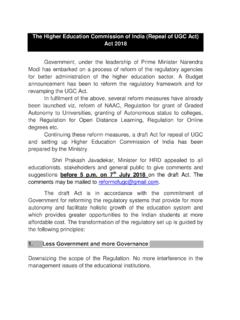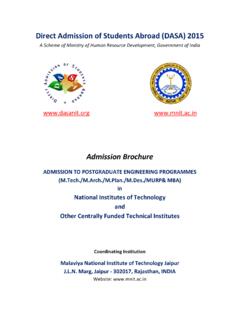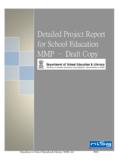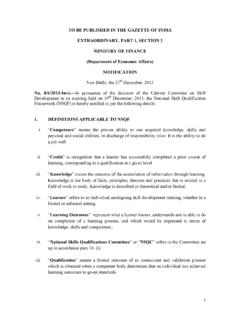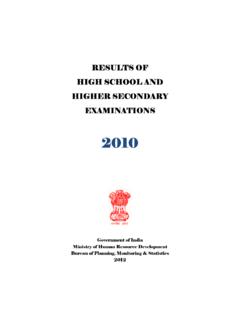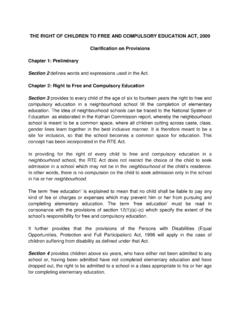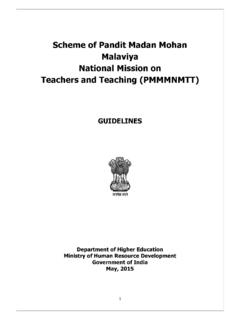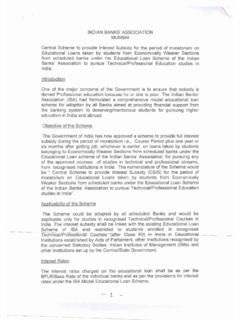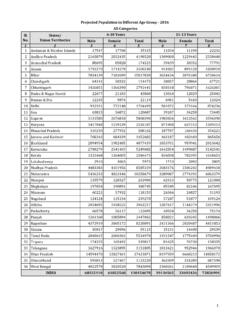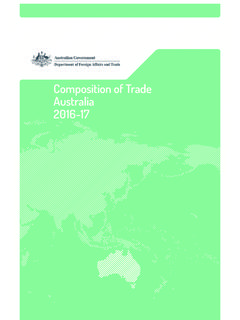Transcription of Swachh Vidyalaya Puraskar - Government of India, …
1 Swachh Vidyalaya PuraskarRecognizing excellence inin schoolsWater, Sanitation and Hygiene Instituted byMinistry of Human Resource DevelopmentGovernment of IndiaWith technical support of:Administrative Staff College of IndiaBella Vista, Hyderabad 500082 Telephone: +91 40 66534221 Website: Nations Children s FundIndia Country OfficeUNICEF House, 73, Lodi Estate, New Delhi 110003 Telephone: +91 11 24690401 Website: Swachh Bharat Swachh Vidyalaya : A National Mission 12. Swachh Vidyalaya Puraskar 2016 33. Who is eligible for the Awards? 34. Methodology for Selection of Schools for the Awards 35. Categories of Awards 56. Stages and Timelines of the Awards Process 6 Annexure 1: Self-Assessment Format for School level Information 7 Annexure 2: List of Indicators 14 Annexure 3: Scoring Method 1511 Swachh Bharat Swachh Vidyalaya :A National MissionWater, Sanitation and Hygiene in Schools plays a significant role in determining the health of children, attendance, dropout rate, and learning outcomes.
2 The provision of water, sanitation and hygiene facilities in school secures a healthy school environment and protects children from illness and exclusion. It is a first step towards a healthy physical learning environment, benefiting both learning and health. Children who are healthy and well-nourished can fully participate in school and get the most from the education being : Swachh Vidyalaya HandbookFigure 1: Swachh Vidyalaya PackageHandwashStationToiletsDrinking WaterOperation and MaintenanceCapacity BuildingIn 2014, The Ministry of Human Resource Development, Government of india launched Swachh Bharat Swachh Vidyalaya (SBSV) initiative to ensure that all schools in india have access to separate functional toilets for boys and girls. The initiative also has its emphasis on promoting safe and appropriate hygiene practices in schools and behavior among children.
3 The Swachh Vidyalaya initiative has defined the essential elements of Water, Sanitation and Hygiene in Schools which are categorized under Water, Sanitation, Handwashing with Soap, Operations and Maintenance, Behavior Change Activities and Capacity is required that the components of this basic minimum package are commonly understood and used by all schools as a means to achieve desired service levels in water, sanitation and hygiene practices. Following the launch of the initiative, the state, district and local governments as well as schools across the country have significantly improved sanitation facilities in schools. They are striving to improve access and have introduced child friendly designs, maintenance practices, effective monitoring using ICT tools, behavior change communication, new financing options and forging partnerships.
4 These good practices need to be recognized and shared for accelerating and sustaining the achievements of the Swachh Vidyalaya are an established entry point for learning. They present an opportunity to engage parents and community in general, either through knowledge dissemination via children or through direct engagement and demonstration at the school. Children are fast learners and adapt their behaviour more easily than adults. Children are also effective role models. They may question existing practices in their households and choose to demonstrate good hygiene. What they learn at school is likely to be passed on to their peers and siblings, and to their own children if they become : Swachh Bharat Swachh Vidyalaya HandbookChildren are Agents of Change32 Swachh Vidyalaya Puraskar 2016 The Swachh Vidyalaya Puraskar is instituted by the Ministry of Human Resource Development, Government of india to recognize, inspire and celebrate excellence in sanitation and hygiene practice in Schools.
5 The explicit purpose of the awards is to honor schools that have undertaken significant steps towards fulfilling the mandate of the Swachh Vidyalaya Campaign. 3 Who is eligible for the Awards?The awards would be open to all Government schools in both rural & urban for Selection of Schools for the Awards The process for identifying and recognizing schools for awards is as below: I. Schools will register and submit information as per the prescribed format (Annexure 1) made available online ( Swachh Vidyalaya Swachh Vidyalaya Puraskar ) or by downloading a mobile app, Swachh Vidyalaya Puraskar . The mobile app can be downloaded from Google Play Store or by giving a missed call @ 07097298400. The registration of schools would be done with the U-DISE code of the The website/mobile app is customized to cater to different categories of schools.
6 III. Schools are expected to provide accurate information as required in the format. IV. The information in the format corresponds to the requirements in Swachh Vidyalaya guidelines. Annexure 2 provides the list of indicators categorized under (a) Water (b) Toilets (c) Handwashing (d) Operations and Maintenance (e) Behavior Change and Capacity Maximum weightage assigned for each of the categories is given in Table 1:Table 1: Weightage Assigned to Swachh Vidyalaya Sub-categoriesSub-CategoriesMaximum ScoreWater22 Toilet28 Handwashing With Soap20 Operations And Maintenance15 Behavior Change And Capacity Building15 TOTA L1004I. The performance of the schools against categories will be scored as per the method given in Annexure On the basis of the scores obtained, the schools would be given a rating as described in Table 2: Table 2: School Rating SchemeScoreRatingRemarks90% - 100% of the NormsGreen/**Excellent Keep it up!
7 !75%- 89% adherence to the NormsBlue/**Very Good 51% - 74% adherence to the NormsYellow/**Good, but there is a scope for improvement 35%- 50% adherence to normsOrange/ **Fair, Needs ImprovementBelow 35% adherence to the NormsRed / *Poor : Needs considerable Improvement* Each school should score a minimum of orange rating in each of the Sub-categories in order to be eligible for any award. 55 Categories of AwardsThe awards are categorized at the District level, State and National level (i) District Level Awards: Open to All Green, Blue and Yellow Rated Schools Online (web/ mobile) applications received before the cut-off date will be screened by a District level Committee headed by the District Collector (or her/his appointee) and comprising of District Education officer, three eminent school teachers, Superintendent Engineer (Water supply / PHD), District Health Officer and two members from civil society organizations/NGOs.
8 RURAL: a) Three Elementary and Three Secondary schools having the highest overall score with rating not below YELLOW will be selected for the District level Award (Total 6) b) In addition, six schools( three elementary and three secondary) having the highest score in each of the Sub Categories with rating not below GREEN in the sub- category will be selected for sub-category wise awards at the district level(Total 30) URBAN: a) Two schools ( one elementary and one secondary)having the highest overall score with rating not below YELLOW will be selected for the District level Award (Total 2) b) In addition, two schools(one elementary and one secondary) having the highest score in each of the Sub Categories with rating not below GREEN in the sub-category will be selected for sub-category award at the district level (Total 10).
9 The district level committee may get a physical verification of the nominated schools done by a team consisting of school teachers and students in the district. The verification would be done using a check list and by taking photographs. Each of the selected schools with highest overall score (Total 8) and each of the schools having the highest score under each sub-category (Total 40) will be awarded with certificate of recognition at district level, provided that all the schools with an overall rating of GREEN would be awarded with a certificate of Recognition.(ii) State/UT Level Awards: Open for Green and Blue Rated Schools Schools selected for District Level Awards with overall rating not less than BLUE will be considered for the State/UT Level Awards. In case the number of Schools in a district having GREEN Rating is more, all the schools having overall GREEN Rating will be considered for State/UT Level Awards.
10 These schools will be screened by a State/UT Level Committee headed by the State Education Secretary or her/his nominee and comprising of Director (Education), Director (Health), two eminent school heads (selected by the State Education Secretary), Chief Engineer (Water Supply & PHD), Director (Panchayati Raj), Director (Urban Local Bodies), representatives of Civil Society Organizations as members. Twenty Elementary and twenty Secondary schools having the maximum score and rating not less than Blue from urban & rural areas (5 from urban and 15 from rural) will be selected for State/UT Level Awards. 6 The State/UT Level Committee may get a physical verification of the selected schools done by a team consisting of school teachers and students in the district. The verification would be done using a check list and taking photographs.
